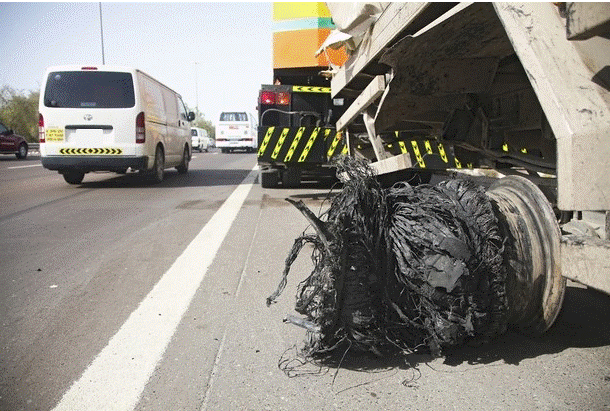
Many of the commercial trucking accident cases we represent share a central issue: unsafe tires and wheels. Unsafe tires and wheels can easily create blowouts or loss of traction which will result in an accident on the road. There are many ways in which a tire or wheel might be deemed “unsafe” and for this reason, commercial trucking regulations insist on a thorough pre-trip, en-route, and post-trip inspection of all tires and wheels. A truck driver who fails to perform these important safety checks may be negligent and could be held accountable for a resulting accident. Additionally, the trucking company that entrusts (hires, trains, and supervises) its vehicles to this negligent trucker, may also bear a burden of responsibility in the event of an accident. The following is a safety checklist for commercial tyre safety:
- Abide by the tire’s maximum recommended speed, which may be lower than posted speed limits.
- Select the right tire for the job, considering the proper tire size, load-carrying capacity, speed capability and service type.
- Tire Pressure – A tire which has too much or too little air pressure could overheat or be vulnerable to a dangerous tire blowout. Set and maintain proper cold inflation pressures. Cold inflation pressure is the inflation pressure of tires before they are driven.
- Tire Wear – If a tire is has extensive wear, such as damaged treads or cracks and bald spots, it may not have adequate traction on the road, making braking and steering dangerous. A worn tire may also be vulnerable to tire blowouts. Inspect tires frequently for damage such as cuts, cracks, bulges and penetrations.
- Minimum Tire Thread (ESMA):
- Light commercial vehicle tyres = 2.4 mm
- Bus and truck tyres = 3.2 mm
- Dual Tire Contact – Commercial vehicles often utilize dual tire configurations, placing two tires in very close proximity to each other. If these two tires actually make contact with each other this can cause a number of problems such as overheating or placing dangerous stress on tire bearings and wheels.
- Mismatched Tire Sizes – It is important that all tires on the commercial vehicle be suitably matched in size. Mismatched tires could cause too much weight to be concentrated on a specific tire or tires, adding too much stress to that tire and possibly resulting in overheating or tire failure.
- Mismatched Tire Types – If a radial tire is used with bias-ply tires, or visa versa, this could also result in a tire overheating, blowing out, or otherwise experiencing tire failure.
- Damaged Rims – It is important that all rims be safe and undamaged. If a rim is cracked it could result in undue stress on the tire, lugs, or lug nuts. This in turn could result in the wheel and tire breaking away from the vehicle.
- Damaged Valve Stems – If a tire’s valve stem is cut, cracked, or otherwise damaged, this could result in the tire losing air pressure and may cause overheating or tire failure.
- Rusting Lug Nuts – If a lug nut is showing evidence of rust this could be an indication that it is loose, and may cause damage to the wheel.
- Loose Lug Nuts – All lug nuts should be checked and proven at least “hand tight” during each inspection. A loose lug nut could cause damage to the wheel.
Oil or Grease on Rims – If there is any oil or grease present on the inside or outside of wheel rims this could indicate that a wheel seal or hub seal is broken or damaged. This in turn could result in bearing failure, or overheating.
Truck drivers are required to check for all of these potential tire and wheel problems each time they conduct a pre-trip, en-route, or post-trip inspection. If they observe any of these problems the commercial vehicle should immediately be taken off the road and not operated again, until the problem is resolved. The initial check should be conducted when the tires are cold (before any driving has been done) to get a proper gauge on tire pressure. Additionally during the trip the truck driver should monitor the wheel area using the vehicle’s mirrors to check for smoke, off-tracking, or uneven tire rotation. If any problem is observed the vehicle should be pulled over immediately.
Finally, truck drivers also have an obligation to pay extra attention to recently serviced tires and wheels since the wheel in question may potentially have loose or otherwise compromised lug nuts which could create danger on the road. Operating a commercial truck comes with an extra layer of responsibility that must be followed for public safety. Truckers who do not perform these safety checks are putting themselves and other motorists at risk each time they get on the road.
credits:
- http://www.claydugas.com
- http://www.prnewswire.com/news-releases/bridgestone-highlights-tire-safety-ahead-of-summer-driving-season-300275931.html
- http://www.esma.gov.ae
Share your story








